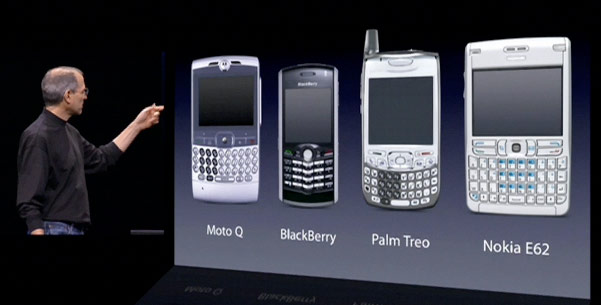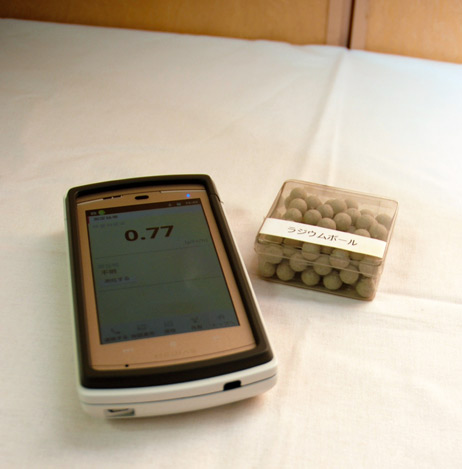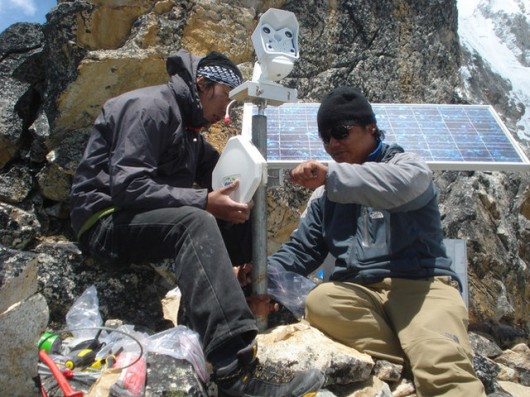Thursday, November 10. 2011
$1,000 Genome in Two Hours by 2012, Says CEO of Ion Torrent
-----
The first human genome cost $3 billion to complete; now we can sequence the entire population of Chicago for the same price
The mythical "$1,000 genome" is almost upon us, said Jonathan Rothberg, CEO of sequencing technology company Ion Torrent, at MIT's Emerging Technology conference. If his prediction comes true, it will represent an astonishing triumph in rapid technological development. The rate at which genome sequencing has become more affordable is faster than Moore's law. (You can read a Q&A TR did with Rothberg earlier this year here, and a profile of his company here).
"By this time next year sequencing human genomes as fast and cheap as bacterial genome," said Rothberg. (Earlier, he'd commented that his company can now do an entire bacterial genome in about two hours.)
I was in the room on October 19 when he said it, and I would have thought it pure hubris were it not for Rothberg's incredible track record in this area, from founding successful previous-generation sequencing company 454 Life Sciences to recent breakthroughs made with the same technology he proposes will get us to the $1,000 genome.
This technology, called, called the Personal Genome Machine, is already being used to determinewhich mutations are present in the genomes of patients' cancers.
 |
The key to this breakthrough, says Rothberg, is that the PGM does not rely on conventional wet chemistry to sequence DNA. Instead, it works almost entirely through conventional microchip technology, which means Ion Torrent is leveraging decades of investment in conventional transistors and chips.
So what's the age of the $1,000 genome look like? Until we know what more of those genes actually correlate with, for most of us it won't be so different from the present.
"Right now don't have very many correlations between those 3 billion base pairs [of the human genome] and outcomes or medicines," says Rothberg. He predicts it will take at least 10 years of clinical experiments with full genome sequencing to get us to the point where we can begin to unlock its value.
"And it will be 20 years before we understand cancer at same level as HIV and can come up with combinations of medicine [tailored] for each individual," says Rothberg.
You can watch a full video of his talk on Tech Review's EmTech site.
Wednesday, October 26. 2011
3D Printing Community to Crowdsource Saving a Species
Miles Lightwood, of TeamTeamUSA, is leading Project Shelter as Makerbot's artist in residence.
Where does 3D printing and species protection intersect? Hermit crabs, apparently. Makerbot Industries, who make do-it-yourself 3D printers, launched Project Shellter last Tuesday. Project Shellter intends to leverage the Makerbot community's design talent and network of 5,000 3D printers to design and produce shells for hermit crabs who face a species threatening, man-made housing shortage. Hmm, sounds familiar.
Bre Pettis, a founder of Makerbot, explains on the Makerbot blog:
Hermit crabs don’t make their own shells. They scavenge their homes. And now, hermit crabs are facing a housing shortage as the worldwide shell supply is decreasing. With a shell shortage, hermit crabs around the world are being forced to stick their butts into bottles, shotgun shells, and anything else they can find. This is not acceptable. As a community, we can reach out to this vulnerable species and offer our digital design skills and 3D printing capabilities and give hermit crabs another option: 3D printed shells.
One of the challenges is that no one knows yet if hermit crabs will live in man-made plastic shells. And if they will, what shell designs would make the best hermit crab homes. Makerbot is setting up a hermit crab habitat in their factory to test shell designs shared by the community.
This is an ingenious crowdsourced intervention, and I encourage you to check it out (follow the #SHELLTER tag Twitter). But, a thought - how about we stop destroying hermit crab homes in the first place? Isn't putting too much plastic stuff in the ocean part of the problem?
UPDATE 10/25:
Some clarification from the Makerbot folks brought up from comments below:
- The final shell material has yet to be determined; plastic is being used for prototypes
- No printed shells have been distributed in the wild
- The goal is to create a printable hermit crab shell for domestic (aquariums) use thus reducing harvesting of natural shells
Tuesday, October 25. 2011
The Apple-fication of everything
Via SplatF
-----
 One of the best things about Steve Jobs’ return to Apple
— which will live on and benefit society long after Jobs’ death — is
how he basically spent the last 14 years teaching thousands of Apple
employees to have incredibly high standards and to build amazing
products.
One of the best things about Steve Jobs’ return to Apple
— which will live on and benefit society long after Jobs’ death — is
how he basically spent the last 14 years teaching thousands of Apple
employees to have incredibly high standards and to build amazing
products.
Perhaps more importantly, through Apple’s products, Steve also taught hundreds of millions of consumers to expect and demand amazing things.
For now, many of those Apple colleagues — especially the ones who worked most closely with Steve — still work there. But over time, more will leave to start their own companies or launch new projects. And some of those companies will make some really cool things completely outside the consumer electronics industry, reflecting both the work of their founders and also a little bit of Steve Jobs.
Today’s example is Nest, a company founded by former Apple iPod co-creator Tony Fadell, which makes thermostats. His product is basically the iPod/iPhone/iMac equivalent of the thermostat.
Yes, it’s not the first thermostat on the market that uses software to “learn” how to heat and cool your house properly, just as the iPod wasn’t the first MP3 player on the market. But it looks great, seems to have a user interface that is well ahead of the competition, reflects modern software and networking capabilities, and has an aspirational brand that I have never seen in a thermostat before.
Did I mention it looks great? See this video on TechCrunch where Fadell explains the attention to detail they put into the Nest, designing the outer metal ring to act as a sort-of mirror, helping the thermostat take on and blend into the colors of the wall behind it. This isn’t just a fancy and functional thermostat, it’s a beautiful one. Go to the “thermostats” page on the Home Depot website – I’ve sorted the results to put the most expensive ones at the top of the page — and see a bunch of white plastic boxes with black-and-green LCD displays. And now you see why the Nest thermostat is exciting people today.

More than anything, this reminds me of the slide of 2006-era smartphones — Motorola Q, BlackBerry Pearl, Palm Treo, Nokia E-something-something – that Steve Jobs displayed before he introduced the iPhone for the first time. Night and day.

Anyway, the Nest is, of course, just one example. It might not even work — it could be a flop. Who knows. That’s not the point.
The idea is that, going forward, integrated hardware, software, and Internet services — the model that Apple has really gotten good at — are going to take over more industries than just computers and pocket gadgets. Everything from your phone (already done, if you have an iPhone) to your car (in progress) to your thermostat (see above) to far-flung sectors of industry and commerce. If it hasn’t been re-imagined yet, it will be eventually.
And while Apple can’t and won’t make all of that stuff itself — part of what makes Apple so successful is its carefully limited domain and obsessive focus — people who worked there and learned from Steve Jobs can. And they increasingly will. And it could be great for all of us.
Monday, October 10. 2011
Japanese company "REAL-f" makes really f-ing accurate 3-D copies of your face
Via io9
-----
If 'Silence of the Lambs' gave you nightmares, you should probably just navigate away from this page right now. Otherwise, prepare to be impressed, intrigued, and deeply disturbed — all at the same time.
You're looking at the work of Japanese company REAL-f. REAL-f specializes in the production of "3-Dimensional Photo Forms," i.e. freakishly realistic masks and busts of just about anybody willing to throw down the cash to have one made of him/herself.
Those interested in possessing an exact replica of their face (down to the level of individual pores and eye vasculature, according to REAL-f's website) can get a 3D "face mask" for US $3,920. A copy of your entire head will set you back US $5,875. Additional face and head copies run $780 and $1,960, respectively.
Do I want one? Absolutely. Would I ever sleep in the same room as my mask? Absolutely not.
You can find more pictures on REAL-f's Website and Facebook Page
Friday, September 30. 2011
Researchers install world’s highest webcam to provide a view of Everest
Via gizmag
-----
After starting out producing security cameras, German-based Mobotix is now taking video surveillance to new heights - literally. One of the company's type-M12 cameras has been situated at an altitude of 5,643-meters (18,514 ft) on the Kala Patthar mountain to stream high definition images of the summit of the nearby 8,848-meter (29,029 ft) high Mount Everest. The solar-powered webcam takes the title of the world's highest webcam from the now second highest webcam in the world located at the 4,389-meter (14,400 ft) high base camp of Mount Aconcagua in Argentina.
The Kala Patthar location, which was chosen for its excellent view of the western side of Everest, including the north and southwest faces of the mountain and the West Ridge, exposes the webcam to some pretty harsh conditions with high winds and temperatures as low as -30°C (-22°F). Images captured by the webcam are transmitted wirelessly to the Ev-K2-CNR Pyramid Laboratory/Observatory, which is located at an altitude of 5,050 meters (16,568 ft). Here, the video is analyzed before being sent onto Italy for further evaluation.
"We spent months developing the perfect setup for the installation and invested a lot of time testing and verifying the system. And it inspired us on to set a record: operating the highest webcam in the world," said Giampietro Kohl, leader of the Ev-K2-CNR technical committee who coordinated the webcam's installation by Italian engineers and the Nepalese Ev-K2-CNR team as part of the "Everest Share 2011" research project,
The research project is taking place as part of the international "Share" climate and environmental monitoring conference, with researchers hoping the images, in conjunction with meteorological data gathered at the world's highest weather station sitting at an altitude of 8,000 meters (26,247 ft) on Mount Everest, will provide an insight into climate change.
People can take in the view provided by the Mobotix webcam from the comfort of their homes by pointing their browsers here. The webcam is only active during the daylight hours of 6:00 a.m. to 6:00 p.m. Nepalese time, with images updated every five minutes to allow the researchers to track the movement of the clouds around the mountain summit. If you'd like to turn the view around and see what it looks like from the summit of Everest, there's also a nice 360-degree panorama here.
Wednesday, September 28. 2011
New DoCoMo smartphone case able to detect radiation
Via Asahi shimbun
-----

NTT DoCoMo Inc. has developed a smartphone case featuring a function that measures radiation levels.
The case has a sensor on it that identifies radiation levels, and the results show up on the screen. A special application must be installed to take advantage of the service.
The new feature, using technologies developed by a domestic dosimeter maker, can determine radiation levels from 0.01 microsieverts to 100 millisieverts per hour, the company said. The device also allows people to access measured values by time on a map using the global positioning system available with the carrier's smartphones.
NTT DoCoMo also developed smartphone cases that enable measurements of ultraviolet rays and body fat percentages. These cases can be switched to monitor various health conditions, the company said. Specific dates for marketing the cases have yet to be decided.
Prototypes of the three cases will be exhibited at Ceatec Japan 2011, Japan's largest exhibition on IT and electronics, to be held Oct. 4-8 at the Makuhari Messe convention center in Chiba Prefecture.
Tuesday, September 27. 2011
Facebook and the 'Like Me’ Election
Via Businessweek
By Elizabeth Dwoskin
-----
New advertising tools from the social media giant let campaigns find and target voters

Charlie Neibergall/AP Photo
Michele Bachmann wants to be your friend. So much so that her campaign is scouring your travels on Facebook for the things that matter to you most. Then she can place a customized message on your page assuring you that those things are important to her, too.
Bachmann did this to great effect in August, when she won the Republican straw poll in Iowa in part by zeroing in on the Facebook pages of potential supporters who lived nearby. Facebookers who had identified themselves as Tea Party supporters or Christian rock fans, or who had posted messages in favor of tax cuts or against abortion, found an ad from Bachmann waiting for them on their profile page in the weeks before the vote, asking for their support and directing them to a link where they could arrange a free ride to the polling place. Bachmann’s campaign says a significant portion of the people who pushed her over the top in Iowa—they won’t say how many—came as a result of the ad campaign.
While some candidates are still trying to get their heads around social media —Rick Perry has been known to block people he doesn’t like from following him on Twitter—Bachmann and other well-funded candidates, including Mitt Romney and Barack Obama, are putting Facebook at the center of their campaign strategies. Working with Facebook’s Washington office, they are taking advantage of just-released advertising tools the company is marketing to politicians.
The software allows candidates to target campaign ads to individuals in ways that weren’t possible a few months ago, reaching them on a site where they spend a lot of time and are less likely to tune out the pitch. “They may not know we’re looking for them,” says Rebecca Donatelli of Campaign Solutions, a social media consulting firm in Alexandria, Va., which was hired by Bachmann. “So we have to give them the opportunity to be found.”
Unlike expensive radio and TV ads, which are blasted out to thousands or millions of people and hit the eyes and ears of as many opponents as supporters, these appeals are often aimed at just a few hundred or even a few dozen potential voters who may never have expressed interest in the candidate. The ads use information Facebook constantly collects about its users to connect with people. “In the last 45 days, I’ve designed over 1,000 ads,” says Michael Beach, a GOP consultant working for Romney.
The campaigns are able to churn out so many ads because Facebook makes it cheap and easy to do, especially compared with TV spots or even Google (GOOG) Ads, which can reach many more people but not necessarily the ones most likely to respond favorably. Facebook ads can be had for 50¢ or less per click—and by counting those clicks, the campaigns know within minutes whether they’re working.
“We’ll throw out four or five different messages targeting different demographics,” says Michael Hendrix, a Dallas-based consultant who works with Donatelli on the Bachmann campaign. “You’re trying to figure out which message will drive a higher response.”
Hendrix’s latest Facebook project is what he refers to as “the gamification of politics.” In virtual reality games such as Facebook’s popular FarmVille, he sees a demographic frontier for Republicans in 2012. He has written software, to be launched later this year, that will allow FarmVille players to get active in politics within the game. Their online characters will be able to go door to door to other players’ imaginary farms, campaigning for real-life candidates and placing yard signs on their lawns. Hendrix is blunt about his intentions. “The majority of social gamers are stay-at-home moms over 38,” says Hendrix. And they vote. He hopes to use the game “to target soccer moms again.”
Facebook’s voter-sifting tools are the same as those it markets to corporations. (Sometimes the same people use the tools for politics and commerce; in addition to his work for Bachmann, Hendrix handles social media for Moët Hennessy (LVMUY), the Champagne maker.) But the pitch is different. The company has stocked its Washington operation with political pros who speak the language of campaigns and elections.
In 2007, Facebook hired Adam Conner, then a 23-year-old Democrat staffer on the House Rules Committee, to help the company break into the capital. He started out slow, teaching politicians the basics of setting up a Facebook page. Democratic politicians were happy to hear Conner’s social media spiel, but some Republicans viewed him with suspicion. So in February, Facebook hired Katie Harbath, a 30-year-old digital strategist for the National Republican Senatorial Committee. Around the office, they’re jokingly known as “the R” and “the D.”
Facebook’s post-industrial space in downtown D.C., where guests are invited to write on the walls with brightly colored Sharpies, may be the most un-Washington workplace in the city. “What I push with folks is that, while the fan count matters, how many people are interacting with it really matters,” says Harbath, who is one of a dozen people working for Facebook in Washington. “How many people are liking it, commenting on it, sharing it with their friends.”
Which raises an important question: Is the effort and money Bachmann and her rivals put into all this liking, commenting, and sharing bringing tangible results that can be measured in volunteers, donations, and ultimately votes next November? The answer is: They don’t know yet. No one has figured out how to “monetize the like,” says Donatelli. What Facebook provides at the moment is an efficient way to reach someone without having to reach everyone and an enormous platform to get a message across without interference from the conventional media. “It’s not in the sheer numbers, but in the intensity of your followers,” Donatelli says. She says that Bachmann fans tend to be issue-driven and feverishly post and cross-post on Facebook, keeping the candidate’s name in the conversation even as her poll numbers slide compared with Romney’s and Perry’s.
Ultimately, Bachmann’s team believes conversation will translate into action and money, like they say it did in Iowa this summer. Otherwise, they say, they wouldn’t bother wasting precious resources on it. “What’s the point of having a fan or a follower if they don’t do anything?” says Donatelli. “At the end of the day, this is a persuasion tool.”
The bottom line: Presidential candidates are targeting potential supporters with Facebook ads, which can cost less than 50¢ a click.
Monday, September 26. 2011
Google digitizes the Dead Sea Scrolls and puts them online
Via Slash Gear
-----
The Dead Sea Scrolls are some of the most famous Christian documents in the world and they are the oldest known biblical manuscripts in existence. The scrolls have a storied history that saw them stashed away inside a series of caves on the shores of the Dead Sea to protect them for the Roman armies that were invading the Holy Land in 68 BCE. The scrolls were lost until 1947 when a shepherd tossed a rock into the cave and discovered the scrolls.

The scrolls have been on exhibit since 1965 at the Shrine of the Book at The Israel museum in Jerusalem. Google has announced that it has now made the Dead Sea Scrolls available online and has digitized all of the content in the scrolls and made that content searchable online. The images of the scroll are high resolution at up to 1200MP to allow the user to see everything about the scrolls.

Google says that you can zoom in on the Temple Scroll and see what the animal skin that the text is written on looks like. The Great Isaiah Scroll can be read chapter and verse. The Hebrew text is also translated into English when clicked. The scrolls went online via a partnership between Google and The Israel Museum, Jerusalem.
---
Friday, September 23. 2011
Amazon Kindle books now available in public libraries
Via myce
---
Amazon has struck a deal with 11,000 U.S. libraries that lets Kindle owners borrow ebooks from the increasingly high-tech institutions. The company said Kindle books accessed through this method will boast a suite of social networking support, including Facebook and Twitter. Additionally, Amazon’s own Whispersync app is supported – which means benefits readers previously needed to scuff up books to enjoy, such as bookmarking and highlighting important passages, are freely available.
“Starting today, millions of Kindle customers can borrow Kindle books from their local libraries,” said Jay Marine, Amazon Kindle director. Marine called libraries “a critical part of our communities” and touted the announcement as an important step in bridging an ever-widening gap between the old and the new.
According to Amazon, the process itself is quick and easy.
Members whose local libraries include the online OverDrive service can visit their official sites and select a title for download. Both an Amazon.com account and active library card are required. Transactions are completed over a Wi-Fi connection or USB transfer. Those without a Kindle can still take part in the program by downloading the company’s free Kindle app on a bevy of other devices, including iPad, BlackBerry and the PC Kindle Cloud Reader.
The closure of Borders stores across the country and the growing popularity of digital media consumption among e-reader and tablet owners may not spell utter doom for paper-bound books, but the convenience of downloading them from your home into a single device is hard to ignore. Amazon’s agreement with libraries proves as much.
The tough part now is getting more people to actually read. Sadly, there’s no app for that.
Thursday, September 22. 2011
Dr. Watson - Come Here - I Need You
Via big think
By Dominic Basulto
-----

The next time you go to the doctor, you may be dealing with a supercomputer rather than a human. Watson, the groundbreaking artificial intelligence machine from IBM that took on chess champions and Jeopardy! contestants alike, is about to get its first real-world application in the healthcare sector. In partnership with health benefits company WellPoint, Watson will soon be diagnosing medical cases – and not just the everyday cases, either. The vision is for Watson to be working hand-in-surgical-glove with oncologists to diagnose and treat cancer in patients.
The WellPoint clinical trial, which could roll out as early as 2012, is
exciting proof that supercomputing intelligence, when properly
harnessed, can lead to revolutionary breakthroughs in complex fields
like medicine. At a time when talk about reforming the healthcare system
is primarily about the creation of digital health records, the
integration of Watson into the healthcare industry could really shake
things up. By some accounts, Watson
is able to process as many as 200 million pages of medical information
in seconds – giving it a number-crunching head start on doctors for
diagnosing cases. In one test case cited by WellPoint, Watson was able
to diagnose a rare form of an illness within seconds – a case that had
left doctors baffled.
While having super-knowledgeable medical experts on call is exciting, it also raises several thorny issues. At what point – if ever - would you ask for a “second opinion” on your medical condition from a human doctor? Will “Watson” ever be included in the names of physicians included in your HMO listings? And, perhaps most importantly, can supercomputers ever provide the type of bedside manner that we are accustomed to in our human doctors?
This last question has attracted much attention from medical practitioners and health industry thought leaders alike. Abraham Verghese,
a professor at the Stanford University School of Medicine as well as
bestselling author, has been particularly outspoken about the inability
of computers to provide the type of medical handholding that we are used to from human doctors.
Verghese claims that the steady digitization of records and clinical
data is reducing every patient to an "iPatient" – simply a set of
digital 1’s and 0’s that can be calculated, crunched, and computed.
Forget whether androids dream of digital sheep – can they take a digital Hippocratic Oath?
Given that the cost of healthcare is simply too high, as a society we will need to accept some compromises. Once the healthcare industry is fully digitized, supercomputers like Watson could result in a more cost-effective way to sift through the ever-growing amount of medical information and provide real-time medical analysis that could save lives. If Watson also results in a significant improvement in patient treatment as well, it’s clear that the world of medicine will never be the same again. Right now, IBM envisions Watson supplementing – not actually replacing - doctors. But the time is coming when nurses across the nation will be saying, “Watson -- Come Here –- I Need You,” instead of turning to doctors whenever they need a sophisticated medical evaluation of a patient.
Quicksearch
Popular Entries
- The great Ars Android interface shootout (130395)
- Norton cyber crime study offers striking revenue loss statistics (100068)
- MeCam $49 flying camera concept follows you around, streams video to your phone (99379)
- The PC inside your phone: A guide to the system-on-a-chip (56683)
- Norton cyber crime study offers striking revenue loss statistics (56297)
Categories
Show tagged entries
Syndicate This Blog
Calendar
|
|
October '25 | |||||
| Mon | Tue | Wed | Thu | Fri | Sat | Sun |
| 1 | 2 | 3 | 4 | 5 | ||
| 6 | 7 | 8 | 9 | 10 | 11 | 12 |
| 13 | 14 | 15 | 16 | 17 | 18 | 19 |
| 20 | 21 | 22 | 23 | 24 | 25 | 26 |
| 27 | 28 | 29 | 30 | 31 | ||






